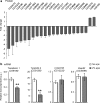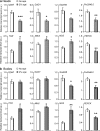A botanical containing freeze dried açai pulp promotes healthy aging and reduces oxidative damage in sod1 knockdown flies
- PMID: 22639178
- PMCID: PMC3705126
- DOI: 10.1007/s11357-012-9437-3
A botanical containing freeze dried açai pulp promotes healthy aging and reduces oxidative damage in sod1 knockdown flies
Abstract
Superoxide dismutase 1 (SOD1), a critical enzyme against oxidative stress, is implicated in aging and degenerative diseases. We previously showed that a nutraceutical containing freeze-dried açai pulp promotes survival of flies fed a high-fat diet or sod1 knockdown flies fed a standard diet. Here, we investigated the effect of açai supplementation initiated at the early or late young adulthood on lifespan, physiological function, and oxidative damage in sod1 knockdown flies. We found that Açai supplementation extended lifespan even when started at the age of 10 days, which is the time shortly before the mortality rate of flies accelerated. Life-long açai supplementation increased lifetime reproductive output in sod1 knockdown flies. Our molecular studies indicate that açai supplementation reduced the protein levels of genes involved in oxidative stress response, cellular growth, and nutrient metabolism. Açai supplementation also affected the protein levels of ribosomal proteins. In addition, açai supplementation decreased the transcript levels of genes involved in oxidative stress response and gluconeogenesis, while increasing the transcript levels of mitochondrial biogenesis genes. Moreover, açai supplementation reduced the level of 4-hydroxynonenal-protein adducts, a lipid peroxidation marker. Our findings suggest that açai supplementation promotes healthy aging in sod1-deficient flies partly through reducing oxidative damage, and modulating nutrient metabolism and oxidative stress response pathways. Our findings provide a foundation to further evaluate the viability of using açai as an effective dietary intervention to promote healthy aging and alleviate symptoms of diseases with a high level of oxidative stress.
Figures





Similar articles
-
Açai palm fruit (Euterpe oleracea Mart.) pulp improves survival of flies on a high fat diet.Exp Gerontol. 2010 Mar;45(3):243-51. doi: 10.1016/j.exger.2010.01.008. Epub 2010 Jan 18. Exp Gerontol. 2010. PMID: 20080168 Free PMC article.
-
Lifespan extension by cranberry supplementation partially requires SOD2 and is life stage independent.Exp Gerontol. 2014 Feb;50:57-63. doi: 10.1016/j.exger.2013.11.020. Epub 2013 Dec 4. Exp Gerontol. 2014. PMID: 24316039 Free PMC article.
-
Nectarine promotes longevity in Drosophila melanogaster.Free Radic Biol Med. 2011 Jun 1;50(11):1669-78. doi: 10.1016/j.freeradbiomed.2011.03.011. Epub 2011 Mar 13. Free Radic Biol Med. 2011. PMID: 21406223 Free PMC article.
-
Role of oxidative stress in Drosophila aging.Mutat Res. 1992 Sep;275(3-6):267-79. doi: 10.1016/0921-8734(92)90031-j. Mutat Res. 1992. PMID: 1383769 Review.
-
Is the oxidative stress theory of aging dead?Biochim Biophys Acta. 2009 Oct;1790(10):1005-14. doi: 10.1016/j.bbagen.2009.06.003. Epub 2009 Jun 11. Biochim Biophys Acta. 2009. PMID: 19524016 Free PMC article. Review.
Cited by
-
Effects of Grape Skin Extract on Age-Related Mitochondrial Dysfunction, Memory and Life Span in C57BL/6J Mice.Neuromolecular Med. 2016 Sep;18(3):378-95. doi: 10.1007/s12017-016-8428-4. Epub 2016 Jul 25. Neuromolecular Med. 2016. PMID: 27455862
-
The value of the Brazilian açai fruit as a therapeutic nutritional strategy for chronic kidney disease patients.Int Urol Nephrol. 2018 Dec;50(12):2207-2220. doi: 10.1007/s11255-018-1912-z. Epub 2018 Jun 18. Int Urol Nephrol. 2018. PMID: 29915880 Review.
-
Cranberry interacts with dietary macronutrients to promote healthy aging in Drosophila.J Gerontol A Biol Sci Med Sci. 2014 Aug;69(8):945-54. doi: 10.1093/gerona/glt161. Epub 2013 Oct 22. J Gerontol A Biol Sci Med Sci. 2014. PMID: 24149429 Free PMC article.
-
A mitochondrial ATP synthase subunit interacts with TOR signaling to modulate protein homeostasis and lifespan in Drosophila.Cell Rep. 2014 Sep 25;8(6):1781-1792. doi: 10.1016/j.celrep.2014.08.022. Epub 2014 Sep 15. Cell Rep. 2014. PMID: 25220459 Free PMC article.
-
Açaí (Euterpe oleracea Mart) Consumption and Prevention of Chronic Diseases: Is There an Association? A Preliminary Study.ScientificWorldJournal. 2020 Jun 1;2020:5782485. doi: 10.1155/2020/5782485. eCollection 2020. ScientificWorldJournal. 2020. PMID: 32565751 Free PMC article.
References
-
- Ashburner M. Drosophila: A laboratory handbook. Plainview: Cold Spring Harbor Laboratory Press; 1989.
-
- Bao Y, Fenwick R. Phytochemicals in health and disease. Oxidative stress and disease 12. New York: Marcel Dekker; 2004.
Publication types
MeSH terms
Substances
Grants and funding
LinkOut - more resources
Full Text Sources
Medical
Molecular Biology Databases
Miscellaneous
